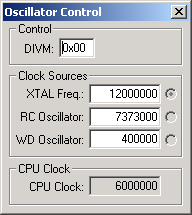|
||
| Products Download Events Support Videos | ||
Product Information
Device Database®
Downloads
Compliance Testing
Distributors
Peripheral Simulation
For NXP (founded by Philips) P89LPC930 — Oscillator Control
Simulation support for this peripheral or feature is comprised of:
- Dialog boxes which display and allow you to change peripheral configuration.
- VTREGs (Virtual Target Registers) which support I/O with the peripheral.
These simulation capabilities are described below.
Oscillator Control Dialog

The Oscillator Control dialog displays and allows you to edit the configuration of the system CPU clock.
Control Group
- DIVM (Divisor Register) is the value that is multipied by 2 then divided into the oscillator to derive the system CPU clock (CCLK).
Clock Sources Group
- XTAL Freq. is the frequency (in Hz) of the simulated crystal.
- RC Oscillator is the RC oscillator frquency (in Hz).
- WD Oscillator is the WD oscillator frquency (in Hz).
CPU CLock Group
- CPU Clock displays the calculated system CPU clock.
RC_OSC VTREG
Data Type: unsigned long
WD_OSC VTREG
Data Type: unsigned long
XTAL VTREG
Data Type: unsigned long
The XTAL VTREG contains the frequency of the oscillator (in Hertz) used to drive the microcontroller. The value is automatically set from the value specified in Project Options - Options for Target. However, you may change the value of XTAL using the command window. For example:
XTAL=12000000
You may also output the current value of XTAL using the following:
XTAL
XTAL may be used in calculations to synchronize external scripts with the simulated microcontroller
ProductsDevelopment Tools |
Hardware & Collateral |
Downloads |
Support |
Contact |
